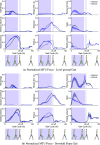Design optimization platform for assistive wearable devices applied to a knee damper exoskeleton
- PMID: 40692812
- PMCID: PMC12277215
- DOI: 10.1017/wtc.2025.10016
Design optimization platform for assistive wearable devices applied to a knee damper exoskeleton
Abstract
Designing optimal assistive wearable devices is a complex task, often addressed using human-in-the-loop optimization and biomechanical modeling approaches. However, as the number of design parameters increases, the growing complexity and dimensionality of the design space make identifying optimal solutions more challenging. Predictive simulation, which models movement without relying on experimental data, provides a powerful tool for anticipating the effects of assistive devices on the human body and guiding the design process. This study aims to introduce a design optimization platform that leverages predictive simulation of movement to identify the optimal parameters for assistive wearable devices. The proposed approach is specifically capable of dealing with the challenges posed by high-dimensional design spaces. The proposed framework employs a two-layered optimization approach, with the inner loop solving the predictive simulation of movement and the outer loop identifying the optimal design parameters of the device. It is utilized for designing a knee exoskeleton with a damper to assist level-ground and downhill gait, achieving a significant reduction in normalized knee load peak value by for level-ground and by for downhill walking, along with a decrease in the cost of transport. The results indicate that the optimal device applies damping torques to the knee joint during the Stance phase of both movement scenarios, with different optimal damping coefficients. The optimization framework also demonstrates its capability to reliably and efficiently identify the optimal solution. It offers valuable insight for the initial design of assistive wearable devices and supports designers in efficiently determining the optimal parameter set.
Keywords: biomechanics; design; exoskeletons; human motor control; optimisation.
© The Author(s) 2025.
Conflict of interest statement
The authors declare none.
Figures









Similar articles
-
Robotic Knee Exoskeletons as Assistive and Gait Training Tools in Spina Bifida: A Pilot Study Showing Clinical Feasibility of Two Control Strategies.IEEE Trans Neural Syst Rehabil Eng. 2025;33:2684-2694. doi: 10.1109/TNSRE.2025.3586801. IEEE Trans Neural Syst Rehabil Eng. 2025. PMID: 40622832
-
Effectiveness of robotic exoskeletons for improving gait in children with cerebral palsy: A systematic review.Gait Posture. 2022 Oct;98:343-354. doi: 10.1016/j.gaitpost.2022.09.082. Epub 2022 Sep 26. Gait Posture. 2022. PMID: 36306544
-
Control strategies used in lower limb exoskeletons for gait rehabilitation after brain injury: a systematic review and analysis of clinical effectiveness.J Neuroeng Rehabil. 2023 Feb 19;20(1):23. doi: 10.1186/s12984-023-01144-5. J Neuroeng Rehabil. 2023. PMID: 36805777 Free PMC article.
-
Automated devices for identifying peripheral arterial disease in people with leg ulceration: an evidence synthesis and cost-effectiveness analysis.Health Technol Assess. 2024 Aug;28(37):1-158. doi: 10.3310/TWCG3912. Health Technol Assess. 2024. PMID: 39186036 Free PMC article.
-
Exoskeletons' design and usefulness evidence according to a systematic review of lower limb exoskeletons used for functional mobility by people with spinal cord injury.Disabil Rehabil Assist Technol. 2016 Oct;11(7):535-47. doi: 10.3109/17483107.2015.1080766. Epub 2015 Sep 4. Disabil Rehabil Assist Technol. 2016. PMID: 26340538
References
-
- Alexander N and Schwameder H (2016) Lower limb joint forces during walking on the level and slopes at different inclinations. Gait & Posture 45, 137–142. - PubMed
-
- Amer NH, Hudha K, Abd Kadir Z, Rahman MLHA and Rahmat MS (2020) Design and characterization of a controllable knee braces with magneto-rheological damper. In 2020 16th IEEE International Colloquium on Signal Processing & its Applications (CSPA), Langkawi, Malaysia: IEEE, pp. 98–101.
-
- Andoh E and Huang X (2023) Magnetorheological damper design and numerical analysis for assistive knee exoskeleton. In 2023 4th International Conference on Mechatronics Technology and Intelligent Manufacturing (ICMTIM), Nanjing, China: IEEE, pp. 62–65.
-
- Auberger R, Pobatschnig B, Russold MF, Riener R and Dietl H (2020) Activities with a microprocessor-controlled leg brace for patients with lower limb paralysis: A series of case studies. IEEE Transactions on Medical Robotics and Bionics 3(1), 137–145.
LinkOut - more resources
Full Text Sources
